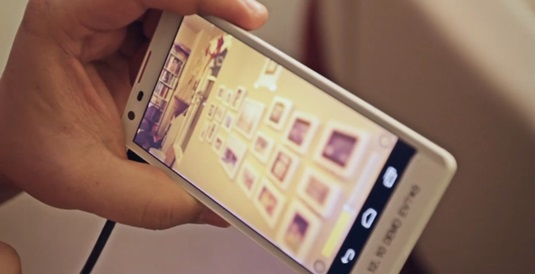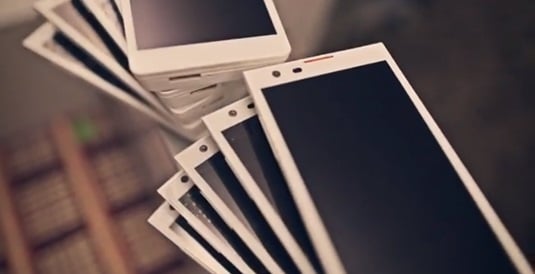Rumors and wish lists aside, we have a pretty good idea of the Samsung Galaxy S5's future feature path.

Will the Galaxy S5 event like look like the S4? We'll see.
(Credit: Josh Miller/CNET)
Wish lists and speculation are one thing. Now it's time to spell out the the design, internal components, and other features that the phone will probably have. Call this educated guessing if you'd like. Samsung may still have some tricks to surprise us, but based on Samsung's past actions and the way the market's moving, here's what I expect we'll see out of this marquee phone.
Design and build
We keep hearing that Samsung has an overhauled design plan for the S5, and possibly a chassis with metal elements. It's certainly true that complaints about the plasticky look and feel of Samsung phones motivated the company to add the ridged silver trim around the
Galaxy S4and the faux-leather "stitching" on the
Galaxy Note 3's back panel.
I'd love to see aluminum parts make an appearance, but rumors aside, I wouldn't be at all surprised if Samsung stuck with its mostly-plastic formula. The inexpensive materials keep phones lighter, production costs lower, and margins higher. Samsung also has its suppliers on lockdown. And as often as some owners and industry-watchers bemoan the lack of premium craftsmanship (myself included), a plastic body hasn't kept Samsung from selling millions of units worldwide.
As far as the rest of the array, we may see an extra sensor or two above the screen, but I expect the layout to remain pretty much as it is now, with a slim bezel around the display and a three-button layout below. Some rumors are pointing to all-touch controls with the Galaxy S5, leaving the physical home button and flanking capacitive buttons behind. Samsung, though, has had great success with the home button. I'd certainly expect to see it make a return to this Galaxy.
As much as I'd love Samsung to change the power button's orientation, or at least the stiffness, I'll be looking for it on the right spine, and for the IR blaster to reappear up top, as it also does on the
Galaxy Note 3 and many Samsung
tablets.
I'm going to guess that Samsung will stick with its usual muted color palette with shades that initially span white to silver to gray to black.

The Galaxy S4's display is one of its best features.
(Credit: Josh Miller/CNET)
Screen standards
The Galaxy S4 has a really nice 5-inch 1080p HD display, but the S5 will have to top that. I stand with the rumors that the phone will carry an
ultra HD resolution of 2,560x1,440 pixels, just like China's
Vivo Xplay 3S. This is, after all, the industry's next step.
And as for the size? Screen size has been creeping up incrementally over the last several years. I don't see the Galaxy S5's display growing beyond 5.2 inches; that would extend well into "phablet" territory and cannibalize the 5.7-inch
Galaxy Note 3.
Right now, those designs are still in R&D mode. While the Samsung Galaxy Round is sold commercially in Korea, this is still a niche product for a limited market. I don't think Samsung would want to take a chance placing a potentially dramatic and polarizing design on a proven hit.

The Galaxy S5 will run Android, but will there be TouchWiz?
(Credit: Josh Miller/CNET)
TouchWiz-flavored Android
Samsung's Android-enhancing TouchWiz overlay is a given for the Galaxy S5. It's Samsung's main vehicle for dispensing heaps of differentiating software extras, and the list grows year after year.
This is what brings us things like that eye-tracking feature I was talking about earlier, as well as lock screen shortcuts, the enhanced quick-access icons in the notification tray, and built-in gestures.
While rumors maintain that Samsung is redesigning TouchWiz -- and maybe scaling it back altogether -- it isn't going anywhere, and I suspect it'll only get beefier, not slimmer, at Samsung keeps adding more features.
Hardware guts
Your heart may flutter at the thought of octa-core processing, and indeed, those chips do exist in phones like the
Huawei Honor 3X.
Yet it's a quad-core chipset I think we'll be seeing on the Samsung Galaxy S5, at least for models released here in the US. Samsung has at times released phones with its in-house Exynos processor in some markets, while stocking shelves in other countries with a Qualcomm chip that uses different radios.
In the US, expect an even faster 2+GHz quad-core
Qualcomm Snapdragon 805 chipset and its Adreno 420 graphics processor. The 805, which
Qualcomm announced in November, bakes in support for 4K video capture and playback and promises 40 percent more powerful graphics processing.
I expect a battery with a capacity hovering around 3,000mAh, storage capacity options for 16GB, 32GB, and 64GB versions, and 3GB RAM. You'll be able to extend storage by at least 64GB using a microSD card.

Expect many camera tricks up the Galaxy S5's sleeve.
(Credit: Sarah Tew/CNET)
Camera and video
I think we're going to see a 16-megapixel camera on the Galaxy S5, if for no other reasons than Samsung will want to move the needle up on all key specs, and that it has experience with this sensor size in a mobile device, the
Samsung Galaxy S4 Zoom (not to mention Samsung cameras.)
Let's also throw in expectations for optical image stabilization, improved low-light performance, and an array of camera filters and tricks. We're entering the era of 5-megapixel front-facing cameras on a handful of devices (
Huawei Ascend Mate 2 4G,
LG G Pro 2); look for it on the S5 as well.
Along with the Snapdragon 805 chip comes 4K video capability. Samsung will still have to turn it on in the Galaxy S5 for it to work, but with LG's G Pro 2 folding in 4K video, the feature seems like a sure thing here, too.

The GS4 also had an infrared sensor that picked up on gestures.
(Credit: Sarah Tew/CNET)
More biometrics
Last year at this time, all the buzz crackled and gathered around rumors of the Galaxy S4's eyeball tracking. The thing is, it wound up being a fringe feature whose most useful application is to pause and resume video, and it built on an optional feature in the Galaxy S3 that kept the screen alight as long as your eyes flitted back to it before it dimmed.
This year, we've already seen Apple and HTC apply pressure with fingerprint scanners of their own. Samsung isn't one to let the competition have all the fun without proffering its own version of a technology. A fingerprint reader on the front makes more ergonomic sense to me than a back panel scanner like the one adorning the
HTC One Max, though Samsung will want to steer clear of infringing on Apple's patents.
Pricing and availability
The wonderful thing about pricing pressure is that it keeps progressively more advanced phones in roughly the same range year after year. The Samsung Galaxy S4 costs between $600 and $700 unlocked, depending on where you live, $200 with carrier subsidies (here in the US), and even less on a special. The Galaxy S5 should follow suit.
We can also expect Samsung to follow suit in terms of getting the phone in buyers' hands relatively quickly, before buzz wears off, people change their minds, or newer phones steal Samsung's thunder. Look for the first Galaxy S5 to go on sale globally in March, a few weeks after the launch event. It'll then cascade into other markets.
No matter what happens, CNET will be on the ground in Barcelona, Spain, bringing you the blow-by-blow news of the Samsung Galaxy S5, and all other important news from
Mobile World Congress.



















